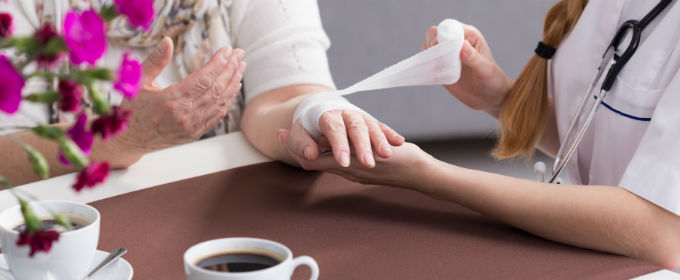The management and care of wounds is a complex aspect of our healthcare system, with implications for primary, secondary, and community care, as well as having a significant impact on both expenditures and outcomes. Here, Paul Wilson of the NIHR Collaboration for Leadership in Applied Health Research and Care Greater Manchester (CLARHRC GM) introduces the issue and significance of wound care research, and the findings of the Greater Manchester team’s work for future approaches to wound management.
- The care of complex wounds is a substantial area of NHS treatment and spending, but have seen a profusion of potential treatment products with significantly different levels of evidence of medical benefits
- The CLARHRC GM team have identified variations in treatment practices across the north of England, with some areas under-using treatments that evidence has shown to be effective, or using treatments and dressings whose effectiveness is less clear
- A reduction in this variation across the region, concentrating on treatments and products with the strongest evidence bases, would deliver better services, better value for money, and better health outcomes for patients
The management of complex wounds is a significant yet often neglected area of care and expenditure in the UK. It is estimated that approximately 80,000 people have one or more complex wound at any one time; these wounds include foot, leg and pressure ulcers. This impact on NHS resources of managing such wounds has been highlighted in a recent debate in the House of Lords with calls made for a national strategy to improve standards of care in the NHS.
Complex wounds occur most frequently in elderly people with one or more co-occurring long-term conditions often described as ‘multimorbidity’. Wounds therefore are invariably a symptom of other conditions. Leg ulcers are usually a consequence of chronic venous disease; diabetic foot ulcers are a consequence of diabetes; pressure ulcers by definition do not occur in healthy people but are due to immobility often the result of other conditions.
Although managed in a variety of healthcare settings, the majority of care for complex wounds in the NHS is delivered by community nurses. These open wounds are usually covered with a wound dressing selected for multiple purposes such as maintaining an optimal environment, protecting against cross infection and for symptom management. There is now a proliferation of different product types available ranging from simple gauze dressings to dressings with different absorptive properties. As dressings are generally classified as medical devices, the threshold for evidence necessary for marketing authorisation is low. This has led to the widespread availability and use of wound care products with little or no compelling evidence of clinical benefit. In contrast, there are treatments, such as two-layer compression hosiery, which are effective but are not used routinely in practice.
Our research: The impact of unwarranted variation
Research by our team at CLAHRC GM highlighted unwarranted variation in clinical practices across wound care services in the north of England. This includes the underuse of evidence-based practices such as compression and overuse of those of low or no known clinical benefit such as antimicrobial dressings. There are therefore significant opportunities for delivering better value wound care across the NHS.
Our efforts are now focused on developing strategies to identify, assess and disinvest from products and practices supported by little or no evidence and to enhance the uptake of those that are. One such example is the ILUMIN leg ulcer quality improvement programme. ILUMIN involves CLAHRC GM working closely with community nurses to support the implementation of some simple changes to practice that should enhance the quality of care delivered. We are carefully evaluating this initiative to inform plans for its wider spread.
Improving standards
Developing strategies to reduce unwarranted variation is but one way to improve standards.
Our data showing unwarranted variation also suggests a skills and knowledge gap among community nurses. We know optimal assessment and treatment make a real difference but the last decade has seen a massive decrease in the numbers of nurses specially trained for working in the community setting. At the same time, continuing professional development (CPD) budgets have been slashed. The important role CPD plays in retention and skill mix is recognised by the Health Committee who have called on Health Education England to reverse previous cuts and to adequately support CPD for nurses working in the community. These cuts seem counterproductive especially with multimorbidity increasingly viewed as ‘the biggest clinical challenge facing the NHS’.
We recognise that significant structural challenges persist but our work in CLAHRC GM shows that we can act to enhance the quality of care delivered and ultimately the outcomes for people with complex wounds. We are therefore ensuring that these insights inform the plans of NHS England as they develop a national wound care strategy for the NHS.
Note:
Paul Wilson (and project colleagues Nicky Cullum and Jo Dumville) are in receipt of funding from the NIHR CLAHRC Greater Manchester. The views expressed in this article are those of the authors and not necessarily those of the NHS, NIHR or the Department of Health and Social Care.
